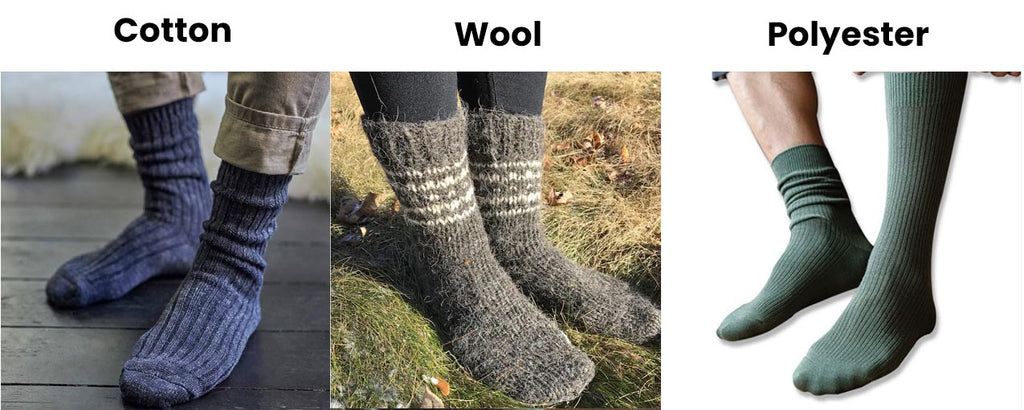When it comes to selecting the right pair of socks, the material is a critical factor that affects comfort, durability, and suitability for different activities. Cotton, polyester, and wool are three common fibres used in sock production, each offering distinct characteristics. Cotton socks are widely appreciated for their softness and breathability, making them a comfortable choice for everyday wear. They are particularly favoured for their gentle touch on the skin and excellent moisture absorption, which can help in keeping feet dry from sweat during less intense activities.
Polyester socks, on the other hand, are synthetic and known for their moisture-wicking properties and quick-drying capabilities. This makes them a suitable option for athletic activities and outdoor adventures where feet may be exposed to moisture. Polyester is also lauded for its durability and resistance to wear and tear, often lasting longer than their cotton counterparts without developing holes. This means you won't need to buy new socks as often.
Wool socks serve as the preferred option in colder climates or for individuals seeking maximum warmth. Wool's natural fibres provide excellent insulation and temperature regulation, keeping feet warm in the winter and cool in the summer. Additionally, wool socks are able to minimise odours, thanks to their antibacterial properties, which is beneficial for extended wear such as hiking or long travel days. Each material brings its own set of benefits and considerations, making the choice between cotton, polyester, and wool socks dependent on personal needs and the intended use.
Material Overview
When considering sock materials, one evaluates characteristics like durability, comfort, and moisture-wicking capabilities. Each material—cotton, polyester, and wool—has distinct properties that suit various needs and preferences.

Characteristics of Cotton Socks
Cotton socks are popular for their softness and natural feel against the skin. They absorb moisture, which can be comfortable for everyday wear, but may not be ideal for activities where sweat is prevalent. Cotton is breathable, making it suitable for warmer climates, and it provides good insulation when dry. These socks are best maintained by washing in warm water and avoiding high heat during drying to retain their shape and size.
Characteristics of Polyester Socks
Polyester socks offer significant advantages in terms of durability and drying time after washing. This synthetic material is known for its strength and resistance to shrinking and wrinkles. It wicks away moisture better than cotton, dries quickly, and is colourfast, which helps maintain its appearance over time. Polyester is also often more affordable and is used in a variety of sock types, ranging from casual to athletic options.
Characteristics of Wool Socks
Wool socks are renowned for their superior insulation properties. Wool naturally regulates temperature, keeping feet warm in cold conditions and cool in heat, which makes them a favoured choice for a variety of outdoor activities. They are also highly absorbent, yet they do not feel wet to the touch, as the fibres wick moisture away from the skin. Due to these properties, wool socks are often preferred for longer durations, such as hiking or other endurance activities.

Comfort and Fit
Choosing the right material for socks greatly influences the comfort and fit for the wearer. Each material, be it cotton, polyester, or wool, offers distinct characteristics that cater to different needs and preferences.
Cotton Sock Comfort
Cotton socks are known for their soft texture and breathability. They are gentle on the skin, making them a good choice for everyday use. However, they tend to retain moisture, which can lead to a damp feel during extended wear or in hotter climates. When it comes to fit, cotton socks may stretch out over time, losing their initial snugness.
Polyester Sock Comfort
In contrast, polyester socks provide superior moisture-wicking properties, keeping feet dry and reducing the chance of blisters. The material is less breathable compared to cotton but offers a closer fit due to its elastic nature, ensuring that the socks maintain their shape even after multiple washes. Given this material is flexible, it's often used for compression socks.
Wool Sock Comfort
Wool socks are highly regarded for their natural insulation that keeps feet warm. They are soft yet resilient, capable of wicking moisture while providing cushioned support. Wool can also minimize odours due to its antimicrobial properties. Wool socks fit snugly and typically do not lose form, making them ideal for outdoor activities in cooler temperatures.
Durability and Maintenance
When considering the durability and longevity of socks, one must evaluate how each material withstands wear and tear over time and the kind of maintenance each type of sock requires to extend its life.
Cotton Sock Durability
Cotton socks are known for their comfort but can be less durable than synthetic fibres. They tend to wear out more quickly, especially in areas of high friction like the heel and toe. To maintain their condition, they should be washed with similar colours and tumble dried on a low setting to prevent shrinkage.
Polyester Sock Longevity
Polyester socks offer excellent durability due to their synthetic nature, resisting abrasion and holding their shape over time. They are quick-drying and generally require minimal care: machine washable and less prone to shrinking, these socks maintain their elasticity and colour even after repeated washing.
Wool Sock Resilience
Wool socks are exceptionally resilient, capable of enduring rigorous use with less pilling and wear compared to other fibres. Wool's natural elasticity helps it to retain shape. Maintenance-wise, wool socks often benefit from being washed in cool water and air-dried, as high heat can cause shrinkage and affect their soft texture.

Thermal and Moisture Properties
In choosing the right socks for certain conditions, one must consider how well they regulate heat and manage moisture.
Cotton Thermal Regulation
Cotton socks are known for their ability to provide insulation. They are a good choice for moderate climates as cotton fibres can absorb moisture and are breathable, keeping the feet relatively warm and dry in cooler conditions. However, they might not be the best option during high-intensity activities or wet conditions as their absorbent nature can lead to a damp feeling once they become wet.
Polyester Moisture Wicking
Polyester, a synthetic material, is highly regarded for its moisture-wicking properties. This means it efficiently moves perspiration away from the skin to the exterior of the socks where it can evaporate more easily. Polyester socks are notably quick-drying, which makes them suitable for sports and other vigorous activities where the feet might sweat, as they help in keeping feet dry and comfortable.
Wool Temperature Balancing
Wool socks, particularly those made from Merino wool, excel in temperature regulation. Due to wool's crimped fibres, it creates tiny air pockets that trap body heat, offering excellent natural insulation. Merino wool can absorb a significant amount of moisture relative to its weight, which aids in keeping feet dry. Additionally, wool can release moisture into the air, helping to keep feet warm in cold settings and cool in warmer conditions, thus offering superior temperature balancing.
Environmental Impact
Selecting socks not only impacts comfort and style but also the environment.
Cotton Sustainability
Cotton production is resource-intensive, requiring significant amounts of water and often relying on harmful pesticides and fertilisers. However, organic cotton offers a more sustainable option, minimising water usage and eliminating the need for chemicals.
Polyester Environmental Considerations
Polyester is derived from petroleum, a non-renewable resource, and its production can release harmful substances. Its durability lends to less frequent replacement, yet it poses challenges in microplastic pollution during washing.
Wool Ethical Sourcing
Wool as a natural fibre has the potential for ethical sourcing. Practices such as responsible land management and humane treatment of sheep contribute to sustainability. Certification by organisations like B Corporation reaffirms ethical sourcing in wool production.
Suitability for Activities
When choosing socks for different activities, one must consider the material's properties such as breathability, moisture-wicking ability, and thermal insulation. Each material - cotton, polyester, and wool - excels in different settings.
Cotton Socks for Daily Wear
Cotton socks are praised for their softness and breathability, making them an ideal choice for everyday comfort. They absorb sweat effectively, which can be a desirable trait for casual usage or in less strenuous environments where rapid drying is not critical.
- Comfort: Offering a gentle touch, suitable for day-long wear.
- Breathability: Allows air to circulate, preventing excessive warmth.
Polyester Socks for Sport
Polyester, a synthetic fabric, is known for its moisture-wicking capabilities and durability. It is particularly appropriate for sports and other high-intensity activities where keeping feet dry is paramount.
- Moisture-Wicking: Transfers sweat from the skin, keeping feet drier.
- Durability: Resists wear and tear even under strenuous conditions.
Wool Socks for Outdoor Adventures
Wool socks are the top contenders for outdoor activities in cooler climates due to their excellent thermal regulation and moisture management. Wool can retain warmth even when wet and is naturally odour-resistant.
- Thermal Insulation: Maintains warmth in cold environments.
- Moisture Control: Manages sweat and can retain insulating properties when damp.

Cost Considerations
When comparing the affordability of cotton, polyester, and wool socks, one must consider both up-front costs and long-term value. Material, durability, and manufacturing processes all play a role in determining the price point of these sock types.
Cotton Sock Affordability
Cotton socks are generally the most cost-effective option, with prices typically ranging from AUD $13-26 per pair. They offer a balance of comfort and casual wear, though they may not last as long as their wool or polyester counterparts due to less durability.
Polyester Sock Pricing
Polyester socks fall into a similar price bracket as cotton, but they often offer better longevity due to their synthetic fibres, which makes the slightly higher price point of AUD $15-30 per pair a worthwhile investment for those seeking durability and moisture-wicking properties.
Wool Sock Investment
Wool socks are typically the most expensive, reflecting their superior durability and temperature regulation properties. Prices for wool socks can range widely, from about AUD $19-£48 per pair, with merino wool options at the higher end due to their softer texture and enhanced benefits.
Allergic Reactions and Skin Sensitivity
In the comparison of different sock materials, one crucial aspect is their potential to cause allergic reactions or skin irritation, which varies from cotton's hypoallergenic qualities to polyester's allergy concerns and wool's irritation factors.
Cotton Hypoallergenic Qualities
Cotton is widely considered to be gentle on the skin due to its hypoallergenic properties. It is a natural fibre less likely to cause allergic reactions, making it a suitable choice for people with sensitive skin. Cotton allows the skin to breathe and reduces the risk of rashes and irritations.
Polyester Allergy Concerns
Conversely, polyester, a synthetic fibre, can. sometimes provoke allergic reactions. It may trap sweat against the skin, leading to irritation for those with sensitive skin. However, not everyone is allergic to polyester, and many can wear it without issue.
Wool Irritation Factors
Wool, a natural protein fibre, can be itchy or irritating to the skin, especially if the fibres are coarse. This is not necessarily an allergic reaction but rather a physical irritation. Finer wool like Merino might be less irritating for some individuals due to its softer texture.
Materials are not the only thing to consider - you also need to think about the different lengths - check out our guide: 9 different types of sock lengths.



















